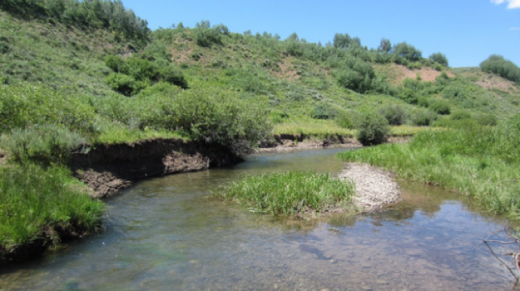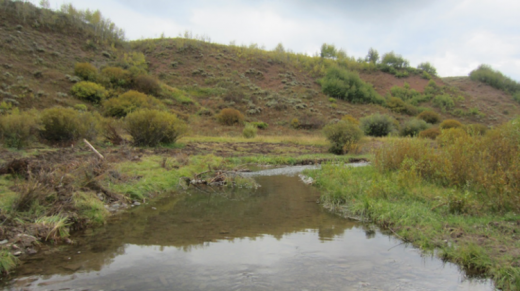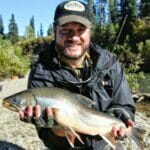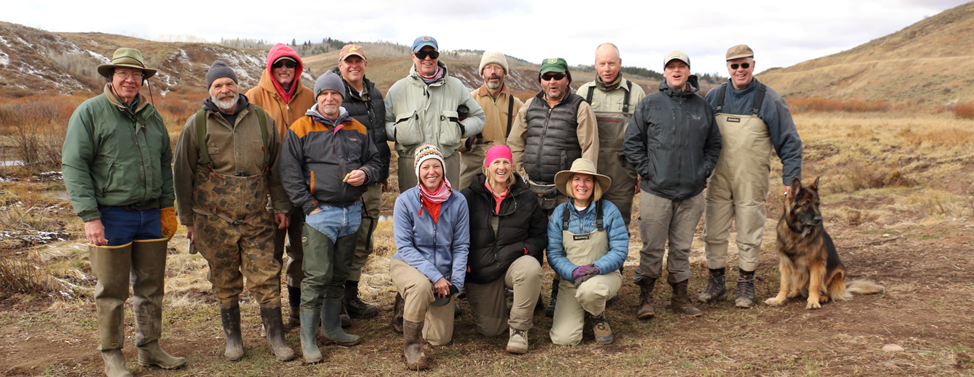Volunteers from the Snake River Cutthroats (Idaho Falls), Star Valley (Wyoming), and Jackson Hole Trout Unlimited chapters braved cold in mid-October 2017 to plant willows, mulch and seed. Kris Millgate/Tight Line Media.
Partners in the Tincup Creek Stream Restoration Project in eastern Idaho near the Wyoming border recently completed Phase 2 of the plan with the final phase slated to be started in 2019 and will continue into 2020.
A new film produced by Kris Millgate at Tight Line Media, appropriately titled “Together,” highlights the partnership involved in the Tincup Project and features people doing the work.
“Tincup is an interesting place,” says U.S. Forest Service Fisheries Biologist Lee Mabey. “Some areas look perfect; like you like them to look. You go around the corner and wonder what happened. It hasn’t gotten degraded to the point we still can’t bring it back.”
Together – Tincup Creek from Trout Unlimited on Vimeo.
Trout Unlimited and the Caribou-Targhee National Forest consider Tincup Creek a conservation priority due to a diverse range of aquatic native species including Yellowstone cutthroat trout (Snake River cutthroat subspecies), northern leatherside chub, boreal toad, western pearl shell mussels and pilose crayfish. Those species are all under special management due to their rarity. Other native species include longnose and speckled dace, sculpin, redside shiners and mountain suckers.

A portion of Tincup Creek before the work showing an outside bend widening into eroding hillslope. Caribou-Targhee National Forest photo.
The creek within the designated project area has been impaired and degraded for over 60 years. The primary cause of the degradation was linked to aerial spraying of willows along the creek in 1956. The loss of willows precipitated the destabilization of the stream and led to the loss of meander bends and stream length, steepened gradients, channel downcutting, and an unhealthy, disconnected floodplain and riparian zone.

An after picture of the same bend from above. The bend has been narrowed, a flooplain added, hillslope recontoured and wood and willows embedded into the bank. Caribou-Targhee National Forest photo.
In 2017 Tincup Creek was named as one of the 10 Waters to Watch by the National Fish Habitat Partnership.
A collaboration of partners started raising money beginning in 2016 – including three Trout Unlimited chapters in two states: Jackson Hole and Star Valley in Wyoming and Snake River Cutthroats in Idaho.
Leslie Steen works as the Snake River Headwaters Project Manager for Trout Unlimited. She got involved with the Tincup Project because the creek eventually ends up connected to the Salt River, a major tributary to the Snake.
“Pretty much every project we work on we work with other folks,” Steen said. “This stream was really over widened with a lot of silt and not a lot of diversity of habitat you typically need for a wild trout population to be healthy.”
The overall goal of the project is to restore the stream channel and floodplain processes to allow for all parts of the system to interact. To accomplish the goal, partners and volunteers built floodplain benches, transplanted whole willows, reconnected historic meanders, added woody debris, elevated riffles and reinforced naturally-occurring beaver dams.
The Tincup Creek Stream Restoration Project received funding from the U.S. Forest Service, Desert Fish Habitat Partnership, Jackson Hole One Fly, Jackson Hole TU chapter, National Forest Foundation, Snake River Cutthroats TU chapter, TU’s Embrace-a-Stream Grant Program, U.S. Fish and Wildlife Service – Idaho, and the Western Native Trout Initiative. Additional in-kind support has been provided by Agrium, Bear Lakes Grazing Association, Caribou County, Idaho Department of Fish and Game, Idaho Transportation Department, and the Star Valley TU chapter.
“I think it’s good you have to work together,” says Kip O’Brien, a rancher on Tincup. “Everybody has to give and take a little to make everybody happy.”



